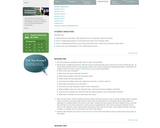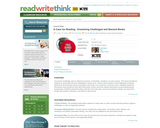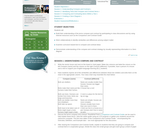
Checklist for students to use while reading articles in Achieve 3000.
- Subject:
- English Language Arts
- Material Type:
- Teaching/Learning Strategy
- Date Added:
- 10/10/2019

Checklist for students to use while reading articles in Achieve 3000.

In this lesson, students explore their towns using a variety of print and nonprint resources. By looking at brochures and other informational tools, students learn about some of the purposes for which people read and write. They also practice writing for a specific audience, revising their writing, and working collaboratively to create a brochure for new students just moving into town.

In this lesson, collaborative groups will read a variety of American tall tales, then report elements of their story to the whole class. Students add story information to a collaborative, whole-class character study matrix that summarizes all the stories. In a writing activity, students compare two characters of their choice. The lesson process is applicable to any set of related texts.

Students will understand and appreciate the work of their bones, muscles, and joints.This educator's guide provides a detailed lesson plan for instruction on the musculoskeletal system. The guide includes questions for discussion, outlines of two classroom activities, a quiz for assessment, and reproducible student handouts. In the first activity, "A Winning Combination," students write a play-by-play commentary describing how the parts of the knee joint work together to kick a soccer ball. In the second activity, "Dr. Build-a-Bone's Laboratory," students read an article about bones (including a cross-section diagram of a bone) to investigate what bones are composed of and how new bone is formed.

Students examine books, selected from the American Library Association Challenged/Banned Books list, and write persuasive pieces expressing their views about what should be done with the books at their school.

In this minilesson, students explore the use of dialogue tags such as “he said” or “she answered” in picture books and novels, discussing their purpose, form, and style. Students identify dialogue tags in stories, collaboratively revise a passage from a novel to add more variety to the tags, and then apply the text structure to stories that they have written.

In this lesson, students learn cause-and-effect relationships by using of a variety of picture books by Laura Joffe Numeroff. They use online tools or a printed template to create an original comic strip for a given writing prompt.

In this lesson, students learn to identify and analyze the compare and contrast text structure within expository texts.

This scientific article explains the historical background and the spreading of the legend. It starts with lady Kunigunde who, after the death of her husband, falls in love with Albrecht the Handsome from Nuremberg. After a misunderstanding she kills her two children from the first marriage. Albrecht leaves her and she dies of sorrow over her dead and her fate. Ever since she has been spooking in the Plassenburg castle. The legend spread in variations as one of the most popular ghost stories all over Germany and into England. The article is written for native speakers 9 years and up.

This article is divided into four parts. The first parts explains the structural features of bones and their role to physically support an organism. The second part focuses on the self-healing ability of bones and how broken bones are medically attended. The third part exemplifies how the sceletal and muscular system are connected with the example of the shinbone. The last part explains the astonishing fact that the number of bones shrinks with growing age, since separate bones during infantry grow together later in life into one bone. The text is written for native speakers age 9 and up.

This article provides information about the adaptation of cacti to drought and protection, as well as basic facts about age, distribution, and varieties. Pictures support the text that is written for native speakers age 8 and up.

This article starts with interesting facts about corn. The two next sections focus on the history of corn as a cultivated plant and the multitude of corn varieties and adaptations. The text is written for native speakers age 8 and up.

This is a scientific report with supporting links and audio files. The discussed sections are: Big Bang, the creation of the universe, creation of the solar system and the planet earth. Two audio files describe different creation stories in different traditions and the search for a second planet Earth. The two supporting files deal with the hypothetical questions of what is beyond the universe and what exactly the Big Bang was. The text is written and spoken in child friendly language for children 8 years and up.

This scientific article discusses two aspects about the sphere shape of our planet: the Earth concept through history of science and gravity as the source for ball-shaped structures in the universe. The text is written in child-friendly language for native readers age 9 and up.

This scientific article describes how glaciers are being created and how it ends in the sea, in rivers or in lakes. Additional information is provided about icebergs and why only the tip of an iceberg is visible. The text is written for native speakers 8 years and up.

This scientific article describes the physical phenomenon of gravitation. Starting with the discovery by Isaac Newton, the article explains the principles of gravitation, but also finds answers to the questions how heavy our planet is and why we still can lift a chair. The text is written for native speakers age 9 and up in child-friendly language.

This scientific article explains the phenomenon of high tide and low tide. It also compares the tide differences in oceans, the Mediterranean, and lakes. The text is written in child-friendly language for native speakers and appropriate for childen 8 years and up

This scientific article explains the historic, social, and economic implications of the invention of the steam engine. It also discusses how the industrial revolution made manufacturing plants independent from locations next to rivers. The last part describes the nostalgic use of historic steam engines. The text is in child-friendly language and appropriate for children age 8 and up.

This article provides a historic background to the fairytales of the fairytales collected by the Brothers Grimm. The original title "Children and Home Fairytales" was first published in 1812. It also focuses on the aspect of cruelty due to the fact they were originally not written for children but to educate common people. An audio link provides an extension of the information and a reflection on modern children stories. The text is written for native speakers age 8 and up. The audio text is spoken in natural language.

In this lesson, students will read for information, make connections and support ideas about Logan’s basketball career and his impact on communities in North Carolina.